Chabrier's L’Étoile Shines Bright for Austin Lyric Opera!
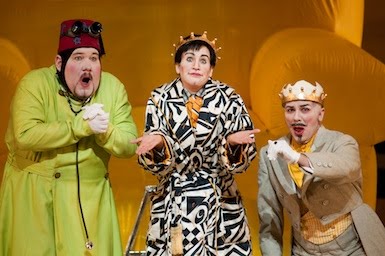
Labels: Austin Lyric Opera, classical music blog, Emmanuel Chabrier, Long Center, L’Étoile

Labels: Austin Lyric Opera, classical music blog, Emmanuel Chabrier, Long Center, L’Étoile
 ed on a short novel by Beni Montresor, for several years a key figure of the New York City Opera. An opera-ballet version was presented at La Scala in December 1995, but the original composition was largely modified and not in line with Glass’ intentions. The Roman version is produced by Musica per Roma in the Parco della Musica and mirrors very closely what Glass wanted. The text can be read in several ways: an initiation process of two children to end up on Venice’s throne (e.g. a modern Mozart’s Magic Flute), a Christmas tale (such as Menotti’s Ahmal and the Night Visitors), the fatigue of an old king in a rapidly changing world (like in Berio’s Un Re in Ascolto), the intrigues of both the political and the performing arts’ environment (as in Strauss’ Capriccio). The final aria, by the chamber maid, is sad (La vita è difficile) but with glimmers of hope (un pò di vino rosso fa cantar): in short, life is difficult but a little red wine makes you sing happily. Le Streghe is quite interesting musically: Glass’ minimalism includes also quotations from Mozart and Rossini as well as a bit of live electronics.
ed on a short novel by Beni Montresor, for several years a key figure of the New York City Opera. An opera-ballet version was presented at La Scala in December 1995, but the original composition was largely modified and not in line with Glass’ intentions. The Roman version is produced by Musica per Roma in the Parco della Musica and mirrors very closely what Glass wanted. The text can be read in several ways: an initiation process of two children to end up on Venice’s throne (e.g. a modern Mozart’s Magic Flute), a Christmas tale (such as Menotti’s Ahmal and the Night Visitors), the fatigue of an old king in a rapidly changing world (like in Berio’s Un Re in Ascolto), the intrigues of both the political and the performing arts’ environment (as in Strauss’ Capriccio). The final aria, by the chamber maid, is sad (La vita è difficile) but with glimmers of hope (un pò di vino rosso fa cantar): in short, life is difficult but a little red wine makes you sing happily. Le Streghe is quite interesting musically: Glass’ minimalism includes also quotations from Mozart and Rossini as well as a bit of live electronics. ction is also a joy for the eyes: in a small theatre for 700 seats, computerized projections, mimes, acrobats and glittering, colourful costumes make the audience feel that a feast is going on. The stage direction (Giorgio Barberio Corsetti) is fast: although the performance starts at 9 p.m. and ends at nearly 11 p.m., the many children in the audience followed the plot with interest and enjoyed the show. Among the voices, worth mentioning are Carmen Romeu, Anna Goryacheva and two children: Matteo Graziani and Francesco Passaretti alternate in the role of the boy and Maria Luisa Paglione and Daniela Sbrigoli in that of the girl. The Contemporanea Ensemble del Parco della Musica is of high quality.
ction is also a joy for the eyes: in a small theatre for 700 seats, computerized projections, mimes, acrobats and glittering, colourful costumes make the audience feel that a feast is going on. The stage direction (Giorgio Barberio Corsetti) is fast: although the performance starts at 9 p.m. and ends at nearly 11 p.m., the many children in the audience followed the plot with interest and enjoyed the show. Among the voices, worth mentioning are Carmen Romeu, Anna Goryacheva and two children: Matteo Graziani and Francesco Passaretti alternate in the role of the boy and Maria Luisa Paglione and Daniela Sbrigoli in that of the girl. The Contemporanea Ensemble del Parco della Musica is of high quality.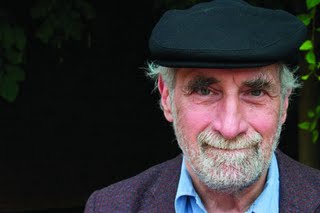 ble was begun one evening in the spring of 1966 by Alan Bryant, Alvin Curran, Jon Phetteplace, Carol Plantamura, Frederic Rzweski (pictured here), Richard Teitelbaum and Ivan Vandor in a room in Rome overlooking the Pantheon. At that time, the Italian capital was a major center for American musicians abroad – more important than Paris and London. To fully grasp the spirit of the time, it is useful to read Marjorie Whright's The Rise and Fall of a La Scala Diva (Janus Publishing Company Ltd, London 2007).
ble was begun one evening in the spring of 1966 by Alan Bryant, Alvin Curran, Jon Phetteplace, Carol Plantamura, Frederic Rzweski (pictured here), Richard Teitelbaum and Ivan Vandor in a room in Rome overlooking the Pantheon. At that time, the Italian capital was a major center for American musicians abroad – more important than Paris and London. To fully grasp the spirit of the time, it is useful to read Marjorie Whright's The Rise and Fall of a La Scala Diva (Janus Publishing Company Ltd, London 2007).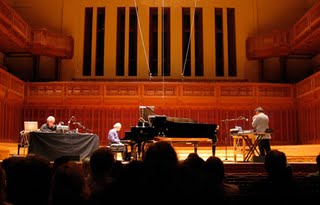 e, Cornelius Cardew's AMM group, the Scratch Orchestra, Nuova Consonanza, Vittorio Gelmetti, Giuseppe Chiari, Kosugi, Ashley, Behrman, Mumma and Lucier. MEV resists retirement and greatly enjoys its one gig a year. Its founding members have each gone on to develop very different but compatible music which in the anarchic MEV tradition stand in strong opposition to the aggressive demands of today's media and marketing moguls.
e, Cornelius Cardew's AMM group, the Scratch Orchestra, Nuova Consonanza, Vittorio Gelmetti, Giuseppe Chiari, Kosugi, Ashley, Behrman, Mumma and Lucier. MEV resists retirement and greatly enjoys its one gig a year. Its founding members have each gone on to develop very different but compatible music which in the anarchic MEV tradition stand in strong opposition to the aggressive demands of today's media and marketing moguls.Labels: Austin Lyric Opera, MEV, Philip Glass, Rome

Labels: Austin Lyric Opera, Barcelona, Gran Theatre del Liceu, King Roger, Spain., Szymanowski
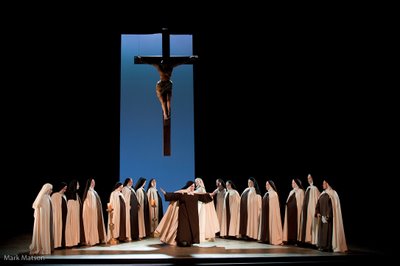
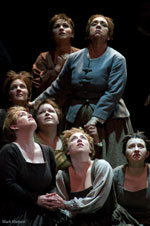 The new Austin Lyric Opera production of Dialogues of the Carmelites makes a powerful case for including this opera in the repertoire.
The new Austin Lyric Opera production of Dialogues of the Carmelites makes a powerful case for including this opera in the repertoire. It is somewhat unfair to single out individuals in such an ensemble effort, but Sheila Nadler as the dying Prioress in Act One – she has sung this role in more than twenty productions of the opera - gave a heart-rending performance, and Jennifer Check as the new Prioress sang with moving eloquence toward the end of Act Two. Emily Pulley (photo: right) as Blanche has the largest role and her personal crisis is at the heart of the opera. She gave a compelling performance and her voice is clearly first-class. Pulley was originally to have played Madame Lidoine, the new Prioress, but the change in casting proved quite satisfactory. Richard Buckley conducted with authority and sensitivity.
It is somewhat unfair to single out individuals in such an ensemble effort, but Sheila Nadler as the dying Prioress in Act One – she has sung this role in more than twenty productions of the opera - gave a heart-rending performance, and Jennifer Check as the new Prioress sang with moving eloquence toward the end of Act Two. Emily Pulley (photo: right) as Blanche has the largest role and her personal crisis is at the heart of the opera. She gave a compelling performance and her voice is clearly first-class. Pulley was originally to have played Madame Lidoine, the new Prioress, but the change in casting proved quite satisfactory. Richard Buckley conducted with authority and sensitivity.
Labels: Austin Lyric Opera, classical travels, Dialogues of the Carmelites, Paul E. Robinson, Poulenc
 After more than 150 years, Rigoletto remains a powerful opera. The characters continue to resonate through the ages because of the universality of their situations and their all too human qualities. In a now legendary production for the English National Opera in 1983, director Jonathan Miller moved the opera from Sixteenth Century Mantua to Little Italy in New York in the mid-Twentieth Century. The story was transformed into an operatic equivalent of the film The Godfather. Audiences loved it and so did the critics.
After more than 150 years, Rigoletto remains a powerful opera. The characters continue to resonate through the ages because of the universality of their situations and their all too human qualities. In a now legendary production for the English National Opera in 1983, director Jonathan Miller moved the opera from Sixteenth Century Mantua to Little Italy in New York in the mid-Twentieth Century. The story was transformed into an operatic equivalent of the film The Godfather. Audiences loved it and so did the critics.
At the age of thirty-eight, Verdi had already written thirteen operas. He was a well-established and experienced man of the theater and on the verge of writing the operas which would make him a figure of international renown.
Based on a play by Victor Hugo, Verdi’s opera Rigoletto was an unlikely choice for a composer in quest of a major success, and succeeded almost in spite of itself. At its opening in 1851, many found it “repulsive and brutal”; others recognized the originality of the music and the depth of characterization. For a general audience there were several hit “tunes”:“Questa o quella” and “La donna è mobile” for the tenor and “Caro nome” for the soprano. All three quickly became famous showstoppers.
Vintage Rigoletto Resonates with Contemporay Audience
In the current Austin Lyric Opera (ALO) production at the Long Center, director Kay Walker Castaldo gives us vintage Rigoletto, as traditional a production as you are likely to see anywhere – with sets from the Cincinnati Opera and costumes from the Minnesota Opera. Castaldo’s straightforward, but compelling production is proof that the greatest operas do not need to be updated to speak to contemporary audiences. What they do need is careful preparation and a team of dedicated artists. Fortunately, for Austin audiences, such a team was assembled by ALO general director Kevin Patterson, and the results are extraordinary.
Captivating Performances and Superb Ensembles
All three principals in the cast – baritone Todd Thomas (Rigoletto), tenor Chad Shelton (the Duke of Mantua), and soprano Lyubov Petrova (Gilda) – were making their Austin debuts in this production, and each one of them emerged triumphant.
 Most impressive of all was Petrova, a young Russian-born singer obviously on the verge of a major career. She made her debut at the Met in 2001 and has sung a variety of roles there since, but she has also been building her repertoire through appearances at many of the regional opera companies in the U.S.
Most impressive of all was Petrova, a young Russian-born singer obviously on the verge of a major career. She made her debut at the Met in 2001 and has sung a variety of roles there since, but she has also been building her repertoire through appearances at many of the regional opera companies in the U.S.
As Gilda, Petrova not only had total command of the coloratura requirements of the role, but also demonstrated remarkable control of phrasing and volume. In the opera’s final scene, as she lies dying, she makes a diminuendo on a long held note that is simply amazing, both in terms of musicianship and characterization.
Let it be said too, that Petrova was very much a team player in this production. She has star quality, but took great care to blend her sound in the great Quartet into the whole, and interacted beautifully in scenes with her father, Rigoletto. Their Act 2 duet was extraordinarily moving.
 In the title role of Rigoletto, Todd Thomas vividly conveyed both the bitterness of this wretched man and his overwhelming love for his daughter. His voice was consistently strong and expressive, and his acting skills helped to heighten and move the drama forward.
In the title role of Rigoletto, Todd Thomas vividly conveyed both the bitterness of this wretched man and his overwhelming love for his daughter. His voice was consistently strong and expressive, and his acting skills helped to heighten and move the drama forward.
The Duke of Mantua gets some of the most crowd-pleasing music in the opera, but he remains the villain of the piece and a thoroughly despicable human being. From the opening scene, Chad Shelton established himself as arrogant and nasty and tossed off his demanding music with aplomb. In “La donna è mobile” his top notes were a little thin, but otherwise his vocal work was very good.
Castaldo’s Direction and Buckley’s Conducting Empower Cast and Orchestra
In a traditional production such as this, the director’s work often goes unnoticed, but clearly Castaldo had a great deal to do with how the singers moved and interacted with one another. In this opera, exaggeration is the road to ruin. The piece is already melodrama and restraint pays great dividends. Wild gestures or gratuitous sobbing come across as superficial. I suspect it was Castaldo who kept things under control in this production, encouraging the performers to call up emotions from within themselves, inspired by Verdi’s music.
 And that brings us to the man who really made it all work - conductor Richard Buckley. It is a pleasure to watch a master at work and Buckley is certainly that. He knows this music from a lifetime of experience, and in rehearsal he is obviously a stern taskmaster. The musical preparation was obvious in the near-impeccable work of the chorus and in the fantastic playing of the orchestra.
And that brings us to the man who really made it all work - conductor Richard Buckley. It is a pleasure to watch a master at work and Buckley is certainly that. He knows this music from a lifetime of experience, and in rehearsal he is obviously a stern taskmaster. The musical preparation was obvious in the near-impeccable work of the chorus and in the fantastic playing of the orchestra.
Buckley unleashed the power of Verdi’s score. He spun out the beautiful long lines and he accompanied the singers with an uncanny feeling for the perfect balance between voices and orchestra. He obviously loves the score and revels in its inspired oddities; for example, the strangeness of the solo cello and solo double bass in the chilling scene between Rigoletto and the assassin Sparafucile, and the wordless chromatic choral writing which gives the final scene much of its horror.
Puzzling Act 1 Scene 2 Set Raises Distracting Questions
Sets and costumes were generally very good, especially in Act 3 (an inn near the river), but the set for Rigoletto’s house and Ceprano’s estate (Act 1, scene 2), I found puzzling. We need to get a sense that Gilda is being held in confinement by her father; instead, she appeared to be living in some kind of enormous palace. Perhaps court jesters in Mantua were doing rather well after all, but such a suggestion undercuts the story. Frankly, I couldn’t tell which was Rigoletto’s place and which was Ceprano’s, and it does matter to the sense of the opera.
The cutaway wall facing the audience also troubled me. The walls are cut away to enable us to see inside rooms and courtyards, and yet characters were still allowed to use that cutaway as a walkway on and off stage. It just didn’t work for me.
Long Center Acoustics Work for Opera!
In some recent Austin Symphony Orchestra reviews, I have complained about the acoustics in the Long Center. When an orchestra is playing in the pit rather than on the stage, however, I must testify that the acoustics are wonderful. I sat in the tenth row of the Orchestra section for this production, and the sound was ideal. The instruments and voices all projected well, and the balances were excellent. The timbres of the various instruments were natural and full, and one could hear a very wide range of dynamics. I have heard three Austin Lyric Opera productions in the Long Center – each time from a different location – and have had the same general impression. Not a thing needs to be changed for the opera acoustics, but I would advise the Austin Symphony to experiment with different seating, perhaps bringing the orchestra further forward on the stage to give the sound a livelier presence in the hall.
Vision, Imagination and Box Office Savvy
Finally, I cannot praise enough the great work general director Kevin Patterson is doing in bringing quality opera productions to Austin. These are tough economic times, and by all accounts they may get even tougher. If anybody can keep the ALO’s head above water, I am confident that it is Kevin Patterson. He obviously chooses repertoire with an eye on the box office, but often gives it a different angle - as in the Austin-oriented Die Fledermaus or the Hollywood-themed La Cenerentola. Even overly-familiar operas gain enormously from the choice of exciting new talents such as Lyubov Petrova. And finally, this season, the ALO was able to give its patrons a new hall, which turns out to be excellent for opera. Kevin Patterson certainly knows how to put it all together.
Paul E. Robinson is the author of Herbert von Karajan: the Maestro as Superstar and Sir Georg Solti: his Life and Music, both available at http://www.amazon.com.
Photos by Mark Matson: Rigoletto and Gilda; Rigoletto; Richard Buckley
Labels: Austin Lyric Opera, classical music, Lyubov Petrova, Richard Buckley, Rigoletto, travel
Classical Travels with Paul E. Robinson
THIS WEEK IN TEXAS
Every month, forty or so music-lovers gather in one of the finest private homes in Austin to listen to chamber music: this is Salon Concerts, now in its nineteenth season.
Salon Concerts was created by two of the finest musicians in the area – violinist Robert Rudié and pianist/composer Kathryn Mishell. As Robert approaches his 90th year, he continues to appear as a violinist in the series – at this concert he played excerpts from Bach’s Sonata No. 1 for Solo Violin with wonderful tone and expression - but more and more of the artistic direction has been taken over by his wife, Kathryn. I joined the group for their latest soirée called Instrumental Magnetism, and enjoyed it immensely, not least of all for the chance to hear a new work by Kathryn.
Made by the Same Master, Violin & Cello Notably Drawn Together
The piece was called "Duo for Violin and Cello: Reunion," and there is a fascinating back story. In the 1860s in Paris, one of the great makers of string instruments was Gand Frères. Of the many instruments produced by the company over the years, two of them found their way to Austin. There was a violin owned by Brian Lewis, a professor of violin at the University of Texas, and a cello owned by Douglas Harvey, principal cellist of the Austin Symphony and the Austin Lyric Opera. In fact, the two instruments were part of a set of four commissioned by Napoleon III and all were made from the same piece of wood!
While the two Austin musicians knew each other, neither knew until recently that the other owned a Gand. Lewis and Mishell had the brilliant idea of bringing the two musicians together to play chamber music on their “Gands.” But more than that, Mishell would bring them together to play music especially written for them and their precious instruments.
Against this background, composer Mishell set to work. As a unifying musical device she used the familiar French nursery song"Frère Jacques," thus indicating 1) the birthplace of the instruments - Paris, France, 2) the makers of the instruments - Gand Frères, and 3) the fact that in being created from the same piece of wood, the two instruments are natural brothers (frères).
Kathryn went a step further. She told me that since the sibling instruments were born in 1863 and 'grew up' in France, they would have known and 'sung' "Frère Jacques" as 'children', as the first publication of the words and music together dates from 1860.
Lewis and Harvey gave a fine performance of the new piece, showing off their Gands and their own considerable talents. Lewis even brought along some coins from the time of Napoleon III to show audience members, in the spirit of the occasion.
Vitizslava Kaprálová's Rarely Performed "Elegy" Rates More Play
The first half of the evening’s program included an impassioned performance of Bohuslav Martinu’s "Three Madrigals" by Lewis and Bruce Williams, principal violist of the Austin Symphony. Lewis and pianist Rick Rowley then presented the rarely-heard "Elegy" by Martinu student Vitizslava Kaprálová. Mishell is well-known for championing women composers – her KMFA radio series Into the Light won a Communicator Award of Distinction last year – and tries to work at least one piece by a woman into each Salon Concerts program.
Kaprálová was a gifted young Czech composer destined to become a major figure. Sadly, her life was cut short by tuberculosis at the age of twenty-five in 1940. The "Elegy" is a beautiful piece and deserves to be better-known. For more on Kaprálová visit the website of the Kaprálová Society. The society is based in Toronto and includes on its advisory board two old friends of mine: pianist Antonin Kubalek and conductor/broadcaster Kerry Stratton.
A Joyous Evening of Intimate Music-making...
The major work on the program was Brahms’ Piano Trio No. 1 in B major Op. 8, played by Lewis, Harvey and Rowley. I prefer the opening tune played with a little more restraint so that one can fully savor its breadth and nobility, but in this performance enthusiasm and the sheer joy of making music carried everything before it. After all, the tempo marking is ‘Allegro con brio’.
I think, however, that I have the composer on my side for the tempo in the slow movement. Brahms marked it ‘Adagio’ and ‘four to the bar’, but pianist Rick Rowley started off at what seemed to me double the tempo, with far too much volume. Surely, those opening chords are meant to suggest almost a suspension of time, just hanging in the air, at a distance, and barely audible. Admittedly, this is difficult to achieve in the living room of a private home - but it can be done.
...Followed by Mixing, Mingling and Fine Food & Wine
As always, the music-making was followed by some world-class cuisine, prepared by the ever-resourceful Chef Pascal.
If I am giving the impression that Salon Concerts is some kind of elitist enterprise, bear in mind that the price tag for the concert and the food was all of $35. Consider also that Salon Concerts manages to raise enough money to maintain its educational activities, in addition to its intimate concert series; the CHAMPS program provides weekly chamber music coaching to over sixty young musicians in Austin’s middle and high schools every year.
Paul E. Robinson is the author of Herbert von Karajan: the Maestro as Superstar and Sir Georg Solti: his Life and Music, both available at http://www.amazon.com. For more about Paul E. Robinson please visit his website.
Blog photo by Marita.
Labels: Anton Kubalek, Austin Lyric Opera, brahms, classical, Kaprálová, Kathryn Mishell, Martinu, Robert Rudie, Salon Concerts, Texas, travel
Labels: Austin Lyric Opera, Dr. Atomic, John Adams, Met in HD, Metropolitan Opera, Texas, travel
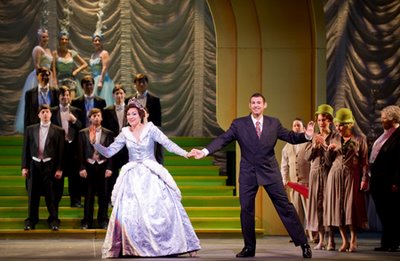
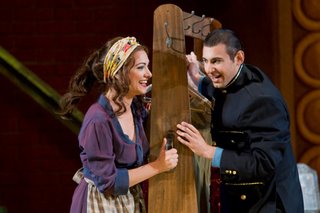 But there can be no La Cenerentola without a great leading lady. The role of Cinderella requires a great comedienne and a mezzo-soprano with mastery of bel canto lyricism and virtuosity. Sandra Piques Eddy may not have erased my personal memories of Cecilia Bartoli’s Cinderella in the near-legendary Houston Grand Opera production of a few years back; nevertheless, she was superb. Her voice is rich and full from top to bottom and she knocked off the technical stuff with almost effortless mastery. Her acting was somewhat less impressive. She handled the transformation from servant to star with conviction, but often seemed less involved than her colleagues. Perhaps director Garnett Bruce simply didn’t give her enough bits of business.
But there can be no La Cenerentola without a great leading lady. The role of Cinderella requires a great comedienne and a mezzo-soprano with mastery of bel canto lyricism and virtuosity. Sandra Piques Eddy may not have erased my personal memories of Cecilia Bartoli’s Cinderella in the near-legendary Houston Grand Opera production of a few years back; nevertheless, she was superb. Her voice is rich and full from top to bottom and she knocked off the technical stuff with almost effortless mastery. Her acting was somewhat less impressive. She handled the transformation from servant to star with conviction, but often seemed less involved than her colleagues. Perhaps director Garnett Bruce simply didn’t give her enough bits of business.Labels: Austin Lyric Opera, blog, classical music, comic opera, conductors, La Cenerentola, Robert Tweten, rossini